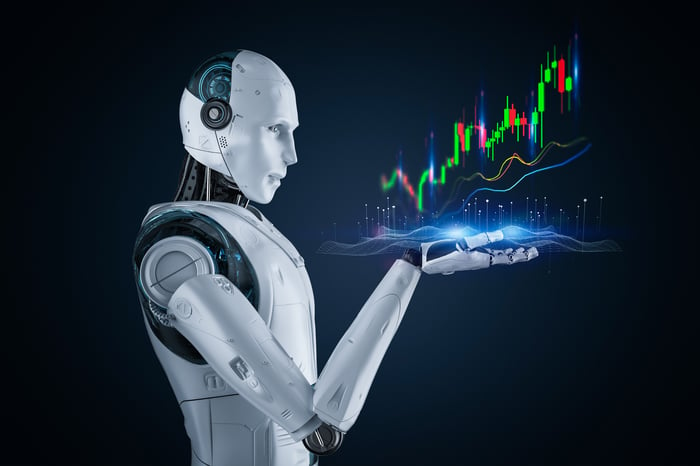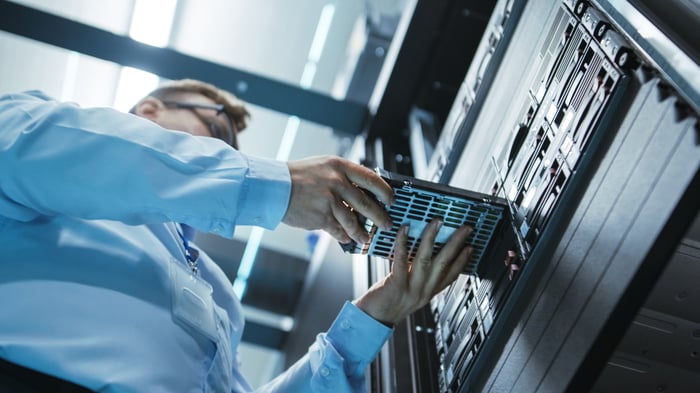Since the advent of the internet roughly 30 years ago, there has been no shortage of next-big-thing investments and top-tier trends vying for investors' attention and capital. Some of the most-promising innovations and trends include genome decoding, nanotechnology, and blockchain technology.
However, nothing has promised to change the growth arc for corporate America since the arrival of the internet quite like the rise of artificial intelligence (AI).
In its simplest form, AI involves the use of software and systems to handle tasks that would normally be overseen by humans. What makes AI special is the ability for software and systems to evolve. Machine learning allows these systems to become smarter and more efficient at what they do over time without human intervention. It's this evolution that gives AI seemingly unlimited potential in virtually all sectors and industries.
According to the researchers at PwC, AI is expected to lift worldwide gross domestic product by up to $15.7 trillion come 2030. Approximately $6.6 trillion of this boost should come from increased productivity, with the remaining $9.1 trillion tied to consumption-side effects.

Image source: Getty Images.
With dollar figures this massive surrounding the AI revolution, it has the look of a can't-miss investment opportunity. But not everything goes as planned.
What follows are three of my artificial intelligence predictions that undeniably go against the grain.
Prediction No. 1: The AI bubble will burst
My first prediction is based entirely on what history tells us should happen.
Every next-big-thing investment and can't-miss trend over the last 30 years, including the internet, genome decoding, housing, nanotechnology, China stocks, 3D printing, cannabis stocks, electric vehicles (EVs), blockchain technology, and the metaverse, all went through a period of early stage investor euphoria that eventually led to a bubble-bursting event.
No matter how game-changing the technology, investors have the uncanny ability to overestimate the uptake/adoption of said technology or trend. Every next-big-thing opportunity needs time to mature, and businesses often need multiple years to figure out how they're going to take advantage of a new innovation.
To be clear, it's impossible to predict when a next-big-thing investment opportunity is going to run out of steam. It took more than four years of extended valuations during the dot-com boom before a bear market took shape. In other words, there's no way to pinpoint when the artificial intelligence bubble will burst.
However, history is undefeated over the last three decades when it comes to these can't-miss opportunities. I'd predict that at some point in the not-too-distant future, the AI bubble will burst.
Prediction No. 2: Nvidia and Tesla will lose more than half of their value when the AI bubble pops
Few publicly traded companies have benefited more from AI than semiconductor titan Nvidia (NVDA -0.44%) and North American EV giant Tesla (TSLA 14.75%).
In just over a year, Nvidia became the face of the AI revolution. Its A100 and H100 graphics processing units (GPUs) have a borderline monopoly in AI-accelerated data centers -- a 90% or greater share of GPUs in use. The recent unveil of Nvidia's all-new Blackwell GPU provides even greater utility for businesses training large language models and offering generative AI solutions to their customers.
Meanwhile, Tesla's next-generation EVs are dependent on incorporating AI solutions. Its EVs rely on cameras and sensors to make split-second decisions to safely navigate their surroundings. Tesla is the only pure-play EV manufacturer that's generating a recurring profit.
While both companies have undeniably been the face of the AI movement, I predict they're both poised to face-plant. If and when the AI bubble bursts, Nvidia and Tesla can lose more than 50% of their current value.
Nvidia's biggest problem looks to be competition. While most folks are aware that Advanced Micro Devices and Intel are gunning for Nvidia's H100 with GPUs of their own -- the MI300X for AMD and Gaudi 3 for Intel -- the bigger threat for Nvidia is coming from within.
For starters, its top four customers, which account for approximately 40% of total sales, are all developing GPUs for their in-house data centers. Whether these are complementary chips or replacements for Nvidia's GPUs, we're likely witnessing a peak in orders from these vital businesses.
Nvidia is also its own competitor. AI-GPU scarcity drove incredible pricing power last year. With the company increasing production as supply chain issues ease, it'll likely be reducing AI-GPU scarcity and clobbering its own gross margin.
Rapidly growing competition is also a problem for Tesla. Since the start of 2023, it's reduced its sales price on Model's 3, S, X, and Y on more than a half-dozen occasions. Despite this aggressive price-cutting campaign to spur sales, Tesla's operating margin has been more-than-halved to 8.2% since the end of September 2022, and the company's inventory levels have been climbing.
Furthermore, Tesla has found little success in its efforts to become more than a car company. Its Services gross margin came in at less than 3% during the fourth quarter, while sales growth for its Energy Generation and Storage business has stalled in recent quarters. More than a third of the company's pre-tax income derives from unsustainable sources, such as interest income and regulatory tax credits.
Lastly, Tesla's efforts to advance its full self-driving (FSD) software haven't gone anywhere. The company's FSD platform has been stuck at Level 2 despite annual proclamations over the last decade from CEO Elon Musk that Level 5 FSD is "one year away."

Image source: Getty Images.
Prediction No. 3: Ancillary AI infrastructure companies and AI facilitators will outperform early stage winners over the long run
The third prediction for the AI revolution is that the early winners, like Nvidia and Tesla, are going to take a back seat over the long run to ancillary infrastructure companies and high-caliber businesses deploying AI solutions.
You'll note by this statement that I do expect artificial intelligence to be a success and eventually change the growth arc for a wide swath of businesses. However, I suspect it'll be years before the technology has matured and most businesses have a blueprint for how they're going to make AI work to their advantage.
Though GPU suppliers are effectively the brains of AI-accelerated data centers, some of the biggest long-term winners could be data-center economy companies that investors have forgotten about. As an example, storage solutions specialist Western Digital (WDC -2.59%) is a company that could benefit immensely from the rise of AI. Enterprise data center storage demand is climbing at a steady pace.
More importantly, Western Digital's NAND flash-memory solutions are in the right place at the right time. NAND flash is non-volatile (i.e., it doesn't have to be powered on to retain its data) and it offers a faster transfer rate than traditional hard-disk drives.
The facilitators that are deploying AI solutions to increase their sales should benefit greatly as well.
For instance, social media powerhouse Meta Platforms (META -2.45%) is one of the "top four customers" I referenced when discussing Nvidia's biggest customers by revenue. Meta is gobbling up Nvidia's H100 GPUs to pair with its own in-house chips to power its data centers.
While it's easy to be enamored with Nvidia for selling what'll likely be in the neighborhood of $10 billion worth of its H100 GPUs to Meta, the sustained potential for outperformance lies with Meta. The parent company of Facebook, WhatsApp, Instagram, and Threads, is deploying generative AI solutions across many of its platforms to help advertisers tailor their ads to its nearly 4 billion monthly active users. Generative AI solutions can provide an even greater boost to Meta's already impressive ad-pricing power.
Meta is also a force to be reckoned with in virtual reality and augmented reality. CEO Mark Zuckerberg is sparing no expense with Meta's Reality Labs division, which has the potential to become a key on-ramp to the metaverse in the latter half of this decade.
The point being that these ancillary infrastructure companies and AI solution facilitators are better positioned to deliver juicier long-term returns than the early stage winners like Nvidia.





